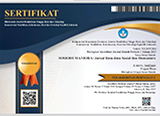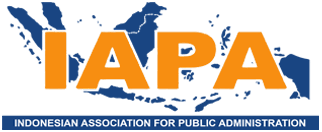ANAK BEKERJA DI INDONESIA: BUKTI EMPIRIS TERHADAP WEALTH PARADOX
Abstract
Banyak penelitian mengungkapkan bahwa keluarga yang semakin miskin akan menyebabkan kejadian anak bekerja lebih banyak (luxury axiom). Akhir-akhir ini, peneliti sudah mulai melihat adanya kondisi dimana keluarga yang mempunyai banyak tanah (keluarga yang lebih kaya), justru membuat fenomena anak bekerjanya lebih banyak (wealth paradox). Kondisi wealth paradox dibayangkan menjadi paradox dari kondisi luxury axiom. Namun demikian, kondisi wealth paradox sebenarnya dapat diintegrasikan ke dalam kondisi luxury axiom. Banyak penelitian tentang anak bekerja di Indonesia yang spesifikasi empirisnya belum dapat menangkap adanya kemungkinan perilaku wealth paradox dan luxury axiom, sehingga penelitian ini mencoba memberikan kontribusi perilaku anak bekerja di Indonesia dengan menggunakan spesifikasi empiris yang dapat menangkap perilaku wealth paradox dan luxury axiom. Penelitian ini bertujuan bertujuan untuk menguji hipotesis wealth paradox dan luxury axiom terhadap anak bekerja di Indonesia dengan menggunakan data IFLS 5. Model yang digunakan di sini adalah tobit dengan instrumental variable. Penelitian ini berhasil membuktikan secara empiris bahwa perilaku wealth paradox dan luxury axiom juga terjadi dalam konteks anak bekerja pada keluarga pertanian di Indonesia.
Keywords
Full Text:
PDFReferences
Amin, S., Quayes, M. S. & Rives, J.M. (2004). Poverty and Other Determinants of Child Labor in Bangladesh. Southern Economic Journal, 70, (4), 876-892.
Basu, K. & Van, P.H. (1998). The Economics of Child Labor. The American Economic Review, 88, (3), 412-427.
Basu, K., Das, S. & Dutta, B. (2010). Child Labor and Household Wealth: Theory and Empirical Evidence of an Inverted-U. Journal of evelopment Economics, 91, (1), 8-14.
Bhalotra, S. & Heady, C. (2003). Child Farm Labor: The Wealth Paradox. World Bank Economic Review, 17, (2),197-227.
Blunch, N. H. & Verner, D. (2000). Revisiting the Link Between Poverty and Child Labor: The Ghanaian Experience. Policy Research Working Paper, 2-21.
BPS, & ILO. (2009). Pekerja Anak Indonesia 2009. Jakarta: Badan Pusat Statistik.
Cameron, A. C. & Trivedi, P.K. (2009). Microeconometrics Using Stat a. Texas: Stata Press.
Chiawaula, L.S. (2010). Household Poverty and Child Labor Decisions in Malawi. Research in Labor Economics, 31, 33-51.
Delap, E. (2001). Economic and Cultural Forces in The Child Labour Debate: Evidence from Urban Bangladesh. The Journal of Development Studies, 37, (4), 1-22.
Edmonds, E.V. (2005). Does Child Labor Decline with Improving Economic Status?. The Journal of Human Resources, 40, (1), 77-99.
Fan, C.S. (2011). The Luxury Axiom, The Wealth Paradox, and Child Labor. Journal of Economic Development. 36, (3), 25-45.
Goto, H. & Mano, Y. (2012). Labor Market Compe-titiveness and The Size of The Informal Sector. Journal of Population Economics, 25, (2), 495-509.
Greene, W.H. (2008). Econometric Analysis. New Jersey: Pearson Prentice Hall.
Heltberg, R. (1998). Rural Market Imperfections and The Farm Size-Productivity Relationship: Evidence from Pakistan. World Development, 26, (10), 1807-1826.
Iryani, B.S. & Priyarsono, D.S. (2013). Eksploitasi terhadap Anak yang Bekerja di Indonesia. Jurnal Ekonomi dan Pembangunan Indonesia. 13, (2), 177-195
Key, N., Sadoulet, E. & de Janvry, A. (2000). Transactions Cost and Agricultural Household Supply Response. American Journal Agricultural Economics, 82, (2), 245–259.
Lima, L.R., Mesquita, S. & Wanamaker, M. (2014). Child Labor and the Wealth Paradox: The Role of Altruistic Parents. Economics Letters, 130, (C), 80-82.
Munawaroh, T. (2012). Pengaruh Kemiskinan Rumah Tangga Terhadap Penawaran Tenaga Kerja Anak di Indonesia. Tesis Program Pascasarjana Ilmu Ekonomi Universitas Indonesia.
Nabawiyah, M. (2014). Pengaruh Kredit Terhadap Pekerja Anak di Provinsi Kalimantan Selatan. Tesis Program Pascasarjana Ilmu Ekonomi Universitas Indonesia .
Nielsen, H.S. (1998). Child Labor and School Attendance: Two Joint Decisions. Centre for Labour Market and Social Research, 1-32.
Pindyck, R.S. & Rubinfeld, D.L. (2009). Microeconomics. New Jersey: Prentice Hall.
Irianti, D. & Riasih, T. (2015). Dukungan Pemerintah Daerah Terhadap Penanganan Anak Jalanan di Kota Pontianak, Propinsi Kalimantan Barat. Sosiohumaniora, 17, (1), 13-20.
Ray, R. (2000). Child Labor, Child Schooling, and Their Interaction with Adult Labor: Empirical Evidence for Peru and Pakistan. The World Bank Economic Reiew, 14, (2), 347-367.
Rizkianto, R., Muflikhati, I. & Hernawati, N. (2013). Nilai Ekonomi Anak, Motivasi, dan Self-Esteem Pekerja Anak. Jurnal Ilmu Keluarga dan Konsumen. 6, (3), 172-179
Sadoulet, E., de Janvry, A. & Benjamin, C. (1996). Houshold Behavior with Imperfect Labor Markets. Journal of Industrial Relations. 37, (1), 85-108
Stanhill, G. (1978). The Fellah’s Farm: an Autarkic Agro-Ecosystem. Agro-Ecosystems. 4, (4), 433-448.
DOI: https://doi.org/10.24198/sosiohumaniora.v21i2.12101
Refbacks
- There are currently no refbacks.
Copyright (c) 2019 Sosiohumaniora

This work is licensed under a Creative Commons Attribution-ShareAlike 4.0 International License.
Sosiohumaniora Indexed By:
 Creation is distributed below Creative Commons Attribution-ShareAlike 4.0 International License.
Creation is distributed below Creative Commons Attribution-ShareAlike 4.0 International License.
Published By:
Faculty of Social and Political Sciences, Universitas Padjadjaran
Dean's Building 2nd Floor, Jalan Ir. Soekarno Km. 21 Jatinangor, Sumedang 45363
Email: jurnal.sosiohumaniorafisip@gmail.com
















